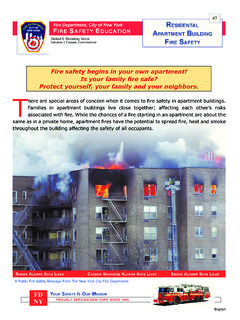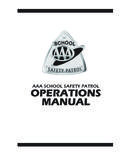Transcription of Health and safety training - hse.gov.uk
1 Page 1 of 6 This is a web-friendly version of leaflet INDG345(rev1), published 11/12 Health and safety ExecutiveHealth and safety training A brief guide This leaflet explains what you, as an employer, may need to do to ensure your employees receive appropriate Health and safety training . It gives advice on who may need training , what form the training may take and how to organise it. The leaflet will also be useful to employees and their representatives. What is training ? training means helping people to learn how to do something, telling people what they should or should not do, or simply giving them information. training isn t just about formal classroom courses.
2 Why provide Health and safety training ? Providing Health and safety information and training helps you to: ensure that people who work for you know how to work safely and without risks to Health ; develop a positive Health and safety culture, where safe and healthy working becomes second nature to everyone; meet your legal duty to protect the Health and safety of your employees. Effective training : will contribute towards making your employees competent in Health and safety ; can help your business avoid the distress that accidents and ill Health cause; can help you avoid the financial costs of accidents and occupational ill Health , such as damaged products, lost production and demotivated staff.
3 Don t forget that your insurance might not cover all these costs. For information on business insurance, go to The law The Health and safety at Work etc Act 1974 requires you to provide whatever information, instruction, training and supervision as is necessary to ensure, so far as is reasonably practicable, the Health and safety at work of your employees. This is expanded by the Management of Health and safety at Work Regulations 1999, which identify situations where Health and safety training is particularly important, eg when people start work, on exposure to new or increased risks and where existing skills may have become rusty or need updating.
4 Like many employers, you may not be in a position to provide this training on your own, in which case you will need competent help. If possible, you should appoint Health and safety ExecutiveHealth and safety training : A brief guide Page 2 of 6one or more of your employees. If you need further help, look at HSE s leaflet INDG420 Getting specialist help with Health and safety for advice at Also, look at which includes detailed advice on choosing and managing a Health and safety consultant. The safety Representatives and safety Committees Regulations 1977 and the Health and safety (Consultation with Employees) Regulations 1996 require you to consult your employees, or their representatives, on Health and safety issues.
5 Representatives appointed under either of these sets of regulations are entitled to time off with pay for training in their duties. For more details on this see: The Health and safety ( training for Employment) Regulations 1990 ensure that learners doing work experience are covered by Health and safety law. There are a number of other regulations that include specific Health and safety training requirements, eg asbestos, diving and first aid. What about self-employed people? If a person working under your control and direction is treated as self-employed for tax and national insurance purposes, they may nevertheless be treated as your employee for Health and safety purposes.
6 You need, therefore, to take appropriate action to protect them. For further guidance on working with contractors and self-employed people, see If you do not wish to employ workers on this basis, you should seek legal advice. Ultimately, each case can only be decided on its own merits by a court of law. Who needs Health and safety training ?You do! Whether you are an employer or self-employed, are you sure that you re up to date with how to identify the hazards and control the risks from your work? Do you know how to get help from your trade association, your local Chamber of Commerce, or your Health and safety enforcing authority? Do you know what you have to do about consulting your employees, or their representatives, on Health and safety issues?
7 If not, you would probably benefit from some training . Your managers and supervisors do! If you employ managers or supervisors they need to know what you expect from them in terms of Health and safety , and how you expect them to deliver. They need to understand your Health and safety policy, where they fit in, and how you want Health and safety managed. They may also need training in the specific hazards of your processes and how you expect the risks to be controlled. Your employees do! Everyone who works for you, including self-employed people, needs to know how to work safely and without risks to Health . Like your supervisors, they need to know about your Health and safety policy, your arrangements for implementing it, and the part they play.
8 They also need to know how they can raise any Health and safety concerns with you. Health and safety ExecutiveHealth and safety training : A brief guide Page 3 of 6 Contractors and self-employed people who may be working for you do! Remember, these people might not be familiar with your working environment and safety systems that you have put in place for regular employees. You should: take into account the capabilities, training , knowledge and experience of workers; and ensure that the demands of the job do not exceed their ability to carry out their work without risk to themselves and others. Some employees may have particular training needs, for example: new recruits need basic induction training into how to work safely, including arrangements for first aid, fire and evacuation; people changing jobs or taking on extra responsibilities need to know about any new Health and safety implications; young employees are particularly vulnerable to accidents and you need to pay particular attention to their needs, so their training should be a priority.
9 It is also important that new, inexperienced or young employees are adequately supervised; employee representatives or safety representatives will require training that reflects their responsibilities;some people s skills may need updating by refresher training . Your risk assessment should identify any further training needs associated with specific risks. How can I do it? Firstly, you should show your commitment so the people being trained recognise that the training is important. You should consult your employees or their representatives on the planning and organisation of the training . You should make sure that you properly prioritise and plan the training needs for your business.
10 You may have appointed somebody to give you competent assistance (see The law ) and they should be able to help. Try the following five-step approach: STEP 1 Decide what training your organisation needs Identify the skills and knowledge needed for people to do their job in a safe and healthy way. Compare these against people s current skills and knowledge and identify the gaps. Review your experience of injuries, near misses or cases of ill Health . Look at your risk assessments to see where information and/or training have been identified as factors in controlling risks. Consider awareness training needs for everyone, including directors, managers and supervisors, including:how you manage Health and safety ; who is responsible for what; the cost to the business if things go wrong; how to identify hazards and evaluate risks; and the hazards encountered and measures for controlling them.















